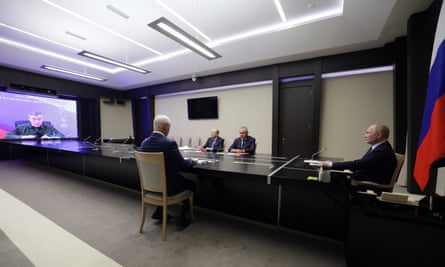Zelenskiy aide says ‘root cause of any escalation’, including into Kursk, is Moscow’s ‘unequivocal aggression’
Ukraine has publicly justified its attack into Russian territory for the first time, amid reports that its forces are advancing towards a village 13 miles (20km) inside the Kursk region on the third day of its incursion.
Mykhailo Podolyak, a senior adviser to the president’s office, said “the root cause of any escalation”, including into Kursk, was “unequivocal aggression” on the part of Russia in believing it could invade Ukraine with impunity.
The statement is the first acknowledgment by any leading Ukrainian official of the ongoing offensive amid silence from the country’s military on events in the Russian region. “War is war, with its own rules, where the aggressor inevitably reaps corresponding outcomes,” Podolyak added.
Ukraine’s president, Volodymyr Zelenskiy, appeared to allude to the incursion on Thursday, saying “everyone can see that the Ukrainian army knows how to surprise” in comments at an event to unveil a new military app.
Later on Thursday, Zelenskiy made another apparent allusion to the offensive in his nightly television address, saying: “Russia brought the war to our land and should feel what it has done.”
Russian military bloggers, currently the most accurate sources of information, reported that fighting was taking place on the highway east of Korenevo, 13 miles north of the border, while the western part of Sudzha, about six miles into Russia, appeared to be under Ukrainian control.
Russia has declared a state of emergency in Kursk and local officials told the Tass news agency that 3,000 civilians had been evacuated following an attack that has clearly caught Moscow off guard.
Ukrainian forces, numbering several hundred according to Russia, burst across the border on the morning of Tuesday, reaching Sudzha on the first day, and since then appear to have pushed up roads to the north-west and north of the town.
Videos have also emerged showing a few dozen Russian troops, including border guards captured at the checkpoint west of Sudzha, being rounded up by Ukrainians on the first day of the raid, demonstrating the initial success.
Russia’s defence ministry said on Thursday its forces “continue to eliminate” the Ukrainian attackers in the Sudzha and Korenevo districts, and that it was targeting the invaders with ground forces, artillery, air and missile strikes.
The same day, Gen Apti Alaudinov, commander of Chechnya’s Akhmat special forces, became the first Russian-aligned military official to acknowledge losses in the country’s military following Ukraine’s surprise incursion.
“The situation is not irreversible, nothing supernatural has happened … Yes, our men have died, that’s a fact. The enemy has entered several settlements,” Alaudinov said in a video message on his Telegram channel.
Alaudinov added that the Ukrainian military had “advanced well into our territory, around 10km”.
A clearly angry Vladimir Putin convened a televised meeting of Russia’s security council on Wednesday, in which the military’s chief of staff, Valery Gerasimov, told him the advance had been halted and that the Kursk operation would be concluded by “reaching the Russian state border”.
Previous incursions from Ukraine into Russia, near the city of Belgorod, have been led by anti-Kremlin Russian groups. But this time the incursion was conducted by Ukrainian forces, using a combination of infantry, armour, drones, electronic warfare and air defence in the attack.

Experts have largely been sceptical about the value of a Ukrainian incursion into Russia, although its progress on the ground has been better than many predicted two days ago, and it has come at a time when Kyiv has been under growing frontline pressure in central Donbas.
Jade McGlynn, a Ukraine expert and research fellow at King’s College London, said: “As a military strategy, I remain a bit puzzled, but as a political strategy, it has been very successful. It suggests yet again that Putin’s ‘red lines’ are only words and that Russia is not as strong as some make out.”
Fears that Russia could retaliate against the west have been behind decisions by the US president, Joe Biden, and others to restrict the use of high-value western weapons, such as F-16 fighters, to territory inside Ukraine’s borders. There has so far been no confirmed reports of their use in the Kursk offensive, although there have been some statements by Russia that Ukraine has been using Stryker and Bradley armoured vehicles.
The US has said it had had no prior knowledge of Ukraine’s plan to attack. John Kirby, the White House national security spokesperson, said the administration had contacted Kyiv to “get a little better understanding” of the Kursk offensive.
Washington also said its restrictions regarding the use of high-value US weapons inside Russia’s internationally recognised borders had not changed, and the state department said the incursion was “not a violation of our policy”.
The main operational Russian gas pipeline into Europe runs near Sudzha, where a metering station – reportedly captured by Ukraine – monitors the reduced Russian supplies to countries such as Austria and Hungary. Kyiv has allowed gas to continue flowing through the pipeline as part of a contract that expires at the end of 2024.
Source: The Guardian











Recent Comments